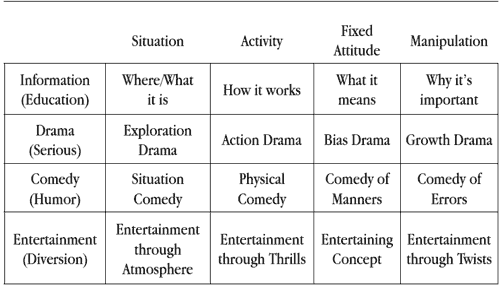Grid of Dramatica Genres
Information (Education):
•Where/What it is--(Information/Situation)--an examination of events and situations with an emphasis on the past, present, progress, and future state of things" (for example Documentary, Historical and Period Pieces).
•How it works--(Information/Activity)--an examination of how specific processes work with an emphasis on instruction (for example Educational, Informational, Instructional).
•What it means--(Information/Fixed Attitude)--an examination of opinions and points of view with an emphasis on the context in which they are made (for example Inspirational, Motivational).
•Why it's important--(Information/Manipulation)--an examination of value systems with an emphasis on providing context relevant to the audience's personal life (for example Persuasion, Propaganda).
Drama (Serious):
•Exploration Drama--(Drama/Situation)--a serious exploration of how the state of things" is unbalanced (for example Courtroom, Crime, and Classroom dramas).
•Action Drama--(Drama/Activity)--a serious take on how problems are created by continuing activities (for example Espionage and War dramas).
•Bias Drama--(Drama/Fixed Attitude)--a serious take on what types of conflicts arise from incompatible attitudes (for example Obsession and Prejudice dramas).
•Growth Drama--(Drama/Manipulation)--a serious take on the attempts to overcome difficulties resulting from manipulations or evolving identities (for example Coming of Age and Dysfunctional Family dramas).
Comedy (Humor):
•Situation Comedy--(Comedy/Situation)--humor drawn from the difficulties created by placing characters in some predicament (for example TV Sitcoms).
•Physical Comedy--(Comedy/Activity)--pratfalls, slapstick, and other forms of humor drawn from physical activities gone awry (for example The Three Stooges and much of Charlie Chaplin's work)
•Comedy of Manners--(Comedy/Fixed Attitude)--humor derived from divergent attitudes, biases, or fixations - often noted as drawing room comedies (for example Jack Benny or Oscar Wilde's The Importance of Being Ernest).
•Comedy of Errors--(Comedy/Manipulation)--humor derived from misinterpretation or, in psychological terms, attribution error (for example Abbott and Costello's Who's on First and several Shakespeare comedies including Twelfth Night).
Entertainment (Diversion):
•Entertainment through Atmosphere--(Entertainment/Situation)--entertainment derived from new, unique, or interesting settings or backgrounds (for example Disaster, Fantasy, Horror, Musical, and Science Fiction)
•Entertainment through Thrills--(Entertainment/Activity)--entertainment derived from new, unique, or interesting activities/experiences -- much like thrill rides at an amusement park (for example Action Adventure, Suspense)
•Entertaining Concept--(Entertainment/Fixed Attitude)--entertainment derived from new, unique, or interesting ideas (for example High Concept piece)
•Entertainment through Twists--(Entertainment/Manipulation)--entertainment derived from new, unique, or interesting forms of audience manipulation (for example Mysteries, Thrillers)
This grid illustrates how the mode of expression can change the impact a Class will have on an audience. If the Activity Class is expressed in terms of Information it would seem like a How to" story. If we choose Comedy as the mode of expression, however, the Activity Class looks more like a story involving physical humor or slapstick."
The beauty of the grid is that it provides authors with a shopping list" of the kinds of impact they may wish to have on their audience. Take time to examine the table fully. Look at the brief explanation of each mode/Class combination. Unlike most of the previous information in this book, this table lends itself to an intuitive feel that ties in much more closely with the Art of Storytelling than with the Elements of Structure.
Taken together, Classes and modes of expression determine the feel of the subject matter in a story. Still, there is one aspect of Genre remaining: Positioning the audience in relationship to the subject matter. To do this, we can make use of the four Dramatica Throughlines. As a brief recap, they are:
•Main Character Throughline--the first person point of view (I) matched with a Class, this Throughline provides the audience with a down in the trenches," personal view of the story.
•Impact Character Throughline--the second person point of view (you) matched with a Class, this Throughline provides the audience with a what's impacting me," impersonal view of the story.
•Subjective Story Throughline--the first person plural point of view (we) matched with a Class, this Throughline provides the audience with a what's it like to be in this type of a relationship," passionate view of the story.
•Overall Story Throughline--the third person point of view (they) matched with a Class, this Throughline provides the audience with a big picture," dispassionate view of the story.

